
Pyrausta despicata, the straw-barred pearl, is a species of moth of the family Crambidae. It was described by Giovanni Antonio Scopoli in his 1763 Entomologia Carniolica.

Hoplomorpha camelaea is a moth in the family Oecophoridae first described by Edward Meyrick in 1888. It is found in Australia, where it has been recorded from Victoria, Queensland, New South Wales and the Australian Capital Territory.

Simyra albovenosa, the reed dagger, is a moth of the family Noctuidae. It is found in most of Europe, then Turkey, Iran, Transcaucasus and into the east Palearctic.
Batrachedra helarcha is a species of moth of the family Batrachedridae. It is found in Australia.
Stenoptilia petraea is a moth of the family Pterophoridae. It is known from India and Sri Lanka.

Ichneutica scutata is a moth of the family Noctuidae. It is endemic to New Zealand. This species can be found in the southern parts of the North Island as well as the eastern parts of the South Island. It is similar in appearance to I. insignis and I. skelloni but can be distinguished as I. scutata is much paler in appearance. It is likely this species inhabits lowland tussock grasslands as well as coastal dunes although it is not common in inland tussock grasslands. The larvae feed on a variety of herbaceous plants such as Plantago and Convolvulus species, Plagianthus divaricatus. It pupates on soil near its host plants. The adults are on the wing from late March to July.

Eucosma cana, the hoary bell, is a species of moth of the family Tortricidae.
Hypatima dissidens is a species of moth in the family Gelechiidae. It was described by Edward Meyrick in 1913. It is found in Mpumalanga, South Africa.
Hypatima euplecta is a species of moth in the family Gelechiidae. It was described by Edward Meyrick in 1904. It is found in Australia, where it has been recorded from Queensland, New South Wales, Victoria and South Australia.
Commatica palirrhoa is a moth in the family Gelechiidae. It was described by Edward Meyrick in 1922. It is found in Peru and Amazonas, Brazil.
Anacampsis inquieta is a moth of the family Gelechiidae. It was described by Edward Meyrick in 1914. It is found in Guyana.
Aristotelia erycina is a moth of the family Gelechiidae. It was described by Edward Meyrick in 1917. It is found in Ecuador and Peru.
Cryptophasa mesotoma is a moth in the family Xyloryctidae. It was described by Edward Meyrick in 1925. It is found on Buru in the Maluku Islands.
Cryptophasa ensigera is a moth in the family Xyloryctidae. It was described by Edward Meyrick in 1925. It is found on New Guinea.
Sphalerostola caustogramma is a moth in the family Xyloryctidae. It was described by Edward Meyrick in 1927. It is found on New Ireland in Papua New Guinea.
Mimozela is a monotypic moth genus in the family Depressariidae. Its only species, Mimozela rhoditis, is found in Australia, where it has been recorded from Queensland. Both the genus and species were first described by Edward Meyrick in 1914.
Eriogenes mesogypsa is a moth in the family Depressariidae. It was described by Edward Meyrick in 1925. It is found in Papua New Guinea and Australia.
Chlamydastis truncatula is a moth in the family Depressariidae. It was described by Edward Meyrick in 1913. It is found in Venezuela.

Ichneutica sapiens is a moth of the family Noctuidae. This species is endemic to New Zealand. I. sapiens is found in the central North Island, in the South Island in Westland and also the southern parts of the South Island, and in Stewart Island. This species inhabits wetland habitat but its life history is unknown as are the host species of its larvae. The adult moths are on the wing between December and early January and are attracted to sugar traps and to light. I. sapiens is very similar in appearance to I. micrastra but is a smaller moth with a shorter wingspan, has differently formed antennae and slightly different forewing markings.

Helastia cymozeucta is a moth of the family Geometridae. It was first described by Edward Meyrick in 1913. This species is endemic to New Zealand and is found in both the North and the upper parts of the South Island. The adults of this species have been observed on the wing from November to January as well as in March.






